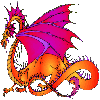
Circumference and the Dragon of Pi
Lesson 3
Time required: 40- 60 minutes.
Vocabulary: circumference, diameter, radius, geometry, pi
Materials Needed:
Sir Cumference and the Dragon of Pi,
various size circles, meter sticks, metric tape measures,
rulers, scissors, Scotch tape, drywall tape, calculators, and table worksheet.
Advanced Preparation:
Purchase the book Sir Cumference and the Dragon of Pi. The book can be found at:
http://amazon.com/exec/obidos/ASIN/1570911649/002-8551063-2848033
Print out the table worksheet found at:
http://evsc.k12.in.us/schoolzone/schools/evans/piday.htm
Illustrative Material:
Show students the vocabulary illustrations found at:
http://math.com/school/subject3/lessons/S3U1L6GL.html
Instructional Objectives:
Students will:
Differentiate between and use appropriate units of measure.
Express the solution clearly by using the appropriate mathematical notation.
Develop generalizations of
the results obtained and apply them in other circumstances.
Activities:
Read Sir Cumference and the Dragon of Pi.
Stop at page 15 and have students complete the
"Discovering Pi" activity at:
http://evsc.k12.in.us/schoolzone/schools/evans/piday.htm
Have students identify the diameter,
circumference, and radius of circular objects.
Demonstrate for the students how to measure the diameter and circumference on a
circle.
Explain that radius is half of the diameter.
Pass out six different
circular-shaped objects. Include many samples of the same size circles.
Working in pairs or in groups have
the students record the diameter and radius of each
circle using a ruler, tape measure, or meter stick using centimeters.
Have students record the information on the table worksheet.
The students should then measure the circumference using drywall tape. The
drywall tape is placed around the perimeter of the circle and marked with a
pencil and then cut. The drywall tape is then measured on a ruler,
tape measure, or meter stick. The circumference is recorded on the table
worksheet.
After the students have recorded the information for the circles , ask the
students if they see a relationship between the diameter and circumference.
Divide the circumference by the
diameter for each circle.
Compare the class' results with the standard value of pi( 3.14159265...).
Write the symbol for pi (p) on the chalkboard.
Finish reading Sir
Cumference and the Dragon of Pi.
At the end of this activity, the students should have a clear understanding
of the relationship between
circumference and diameter and be able to apply this knowledge to similar
situations.
Performance Assessment:
The students will measure the diameter of six circular objects and calculate the circumference.
Extensions:
Have students complete the Pi Day Scavenger Hunt. The questions can be found at:
http://expage.com/piinfo
Homework: Ask students to bring in pies for Pi Day.
Lesson
1
Lesson 2
Lesson 3
Lesson 4